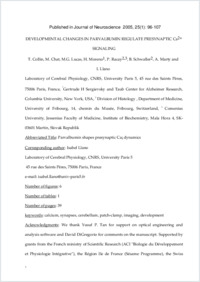Developmental changes in Parvalbumin regulate presynaptic Ca²⁺ signaling
- Collin, Thibault Laboratory of Cerebral Physiology, Centre National de la Recherche Scientifique, University Paris, France
- Chat, Mireille Laboratory of Cerebral Physiology, Centre National de la Recherche Scientifique, University Paris, France
- Lucas, Marie Gabrielle Laboratory of Cerebral Physiology, Centre National de la Recherche Scientifique, University Paris, France
- Moreno, Herman Gertrude H. Sergievsky and Taub Center for Alzheimer Research, Columbia University, New York, USA
- Racay, Peter Division of Histology, Department of Medicine, University of Fribourg, Switzerland
- Schwaller, Beat Division of Histology, Department of Medicine, University of Fribourg, Switzerland
- Marty, Alain Laboratory of Cerebral Physiology, Centre National de la Recherche Scientifique, University Paris, France
- Llano, Isabel Laboratory of Cerebral Physiology, Centre National de la Recherche Scientifique, University Paris, France
-
05.01.2005
Published in:
- The Journal of Neuroscience. - 2005, vol. 25, no. 1, p. 96-107
English
Certain interneurons contain large concentrations of specific Ca²⁺-binding proteins (CBPs), but consequences on presynaptic Ca²⁺ signaling are poorly understood. Here we show that expression of the slow CBP parvalbumin (PV) in cerebellar interneurons is cell specific and developmentally regulated, leading to characteristic changes in presynaptic Ca²⁺ dynamics (Cai). Using whole-cell recording and fluorescence imaging, we studied action potential-evoked Cai transients in axons of GABA-releasing interneurons from mouse cerebellum. At early developmental stages [postnatal days 10-12 (P10-P12)], decay kinetics were significantly faster for basket cells than for stellate cells, whereas at P19-P21 both interneurons displayed fast decay kinetics. Biochemical and immunocytochemical analysis showed parallel changes in the expression levels and cellular distribution of PV. By comparing wild-type and PV(-/-) mice, PV was shown to accelerate the initial decay of action potential-evoked Cai signals in single varicosities and to introduce an additional slow phase that summates during bursts of action potentials. The fast initial Cai decay accounts for a previous report that PV elimination favors synaptic facilitation. The slow decay component is responsible for a pronounced, PV-dependent, delayed transmitter release that we describe here at interneuron-interneuron synapses after presynaptic bursts of action potentials. Numerical simulations account for the effect of PV on Cai kinetics, allow estimates for the axonal PV concentration (∼150 µM), and predict the time course of volume-averaged Cai in the absence of exogenous buffer. Overall, PV arises as a major contributor to presynaptic Cai signals and synaptic integration in the cerebellar cortex.
- Faculty
- Faculté des sciences et de médecine
- Department
- Département de Médecine
- Language
-
- English
- Classification
- Biological sciences
- License
-
License undefined
- Identifiers
-
- RERO DOC 4883
- DOI 10.1523/JNEUROSCI.3748-04.2005
- Persistent URL
- https://folia.unifr.ch/unifr/documents/299796
Statistics
Document views: 160
File downloads:
- Texte intégral: 331
